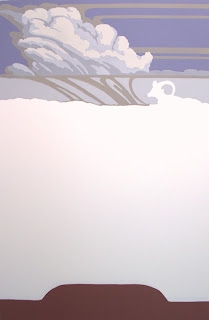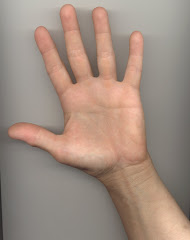In the photo at the right, you are seeing the upper third of the image area -- at this stage the rest of the image area is still just the white paper. In this photo there are two colors: The purplish sky (pulled first) and the lighter bluish tone beneath where the thunderhead will be. Where these first two colors overlap it has the effect of creating a third color. I masked out the remainder of the image area, including the far ram (seen here as white.)

Photo at the above is at the five color stage. The thunderhead is starting to take on a nice decorative shape.
Photo above is at the six color stage. At this point I decided to stop working on the sky portion of the image and tackle the main body of the serigraph, and especially the lettering that would appear at the bottom of the image.
Photo above shows the 7th color now added at the bottom of the image. Again, I should note that colors are not entirely true in these photos (for example, the blank area is actually pure white of the paper still.)--and also there is some distortion due to having to photograph at too close a distance. The brown area (actually a salmon-ish brown color) was pulled for the sake of the lettering as seen once the next color is pulled.
Photo above shows the nine color stage. Again, some distortion due to the camera---the actual serigraphs are nice and straight/squared as are the straight lines of the shape that contains the lettering. Prior to pulling the peachy color over the brown, I hand-brushed the mucilage block-out over each letter (which I'd free-hand drawn onto the screen.)
If you have any questions about my process up to this point, please feel free to email me or, if you've accessed this posting via my Facebook page, then please leave comments/questions there. I will try to reply in a timely manner.


















What is the size of the serigraph?
ReplyDeleteThe image size is 30 inches by 19 inches. It will frame out at about 40 by 28 inches (that would be with a 4 inch mat top/sides and 5 inch at bottom plus a half inch space all around the image so the serigraph edges show and the edition #, title and signature in pencil will show at the bottom.
ReplyDelete